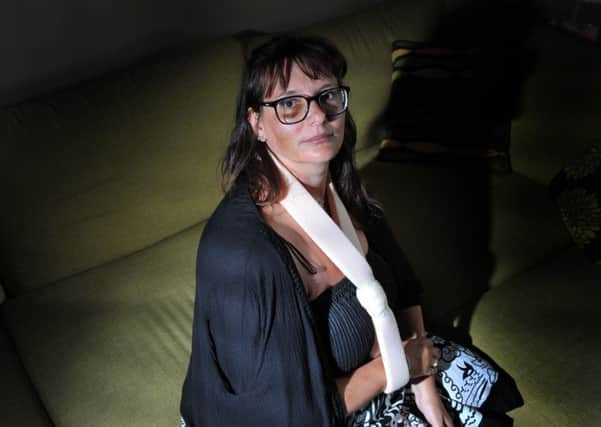Hospital's challenges in recruiting emergency room staff


A trial period is underway at the Friarage Hospital in Northallerton which sees critical and urgent patients diverted by ambulance to Middlesbrough overnight. The move is among a raft of measures, branded “closure by stealth” of the hospital’s A&E department, which are under review as part of the three month scheme.
The current model is “not sustainable” due to workforce challenges and those of a rural population, the district’s CCG has said in a statement on its websites, explaining the trial which was introduced at the end of March.
Advertisement
Hide AdAdvertisement
Hide Ad“Despite considerable efforts by South Tees Hospitals NHS Foundation Trust to recruit, the development of a new Urgent and emergency care model that includes primary care is therefore critical to maintaining 24 hour/365 days a year services based on the hospital site,” said Hambleton, Richmondshire and Whitby CCG.
Unpublished documents, seen by The Yorkshire Post and detailing the full measures in place during the trial, show there are no longer A&E doctors in the casualty department on an evening, with patients assessed instead by paramedics, nurses and GPs.
A ‘gatekeeper’ decides if patients are admitted when they arrive or are sent to an out of hours GP, while those with critical care needs are diverted to James Cook Hospital in Middlesbrough, a 40 minute drive away.
One source, who asked not to be named but who described themselves as a concerned healthcare professional, said: “This is closure of an A&E department by stealth and trying to circumvent the normal public consultation process.”
Advertisement
Hide AdAdvertisement
Hide AdThe news comes as a Yorkshire mother speaks of her fears over the future of local NHS provision, having waited an hour-and-a-half for an ambulance after a fall this week, only to be told there were none available.
“It’s a big area to cover, right across the Yorkshire Dales,” said Karla Bishop-Loach, who had to find her own way to hospital with a broken shoulder.
County Councillor John Blackie, representing the Upper Dales, has raised further concerns that the changes are being brought in with no public consultation.
“Front line emergency ambulance staff do an absolutely first class job,” he said. “However the demands being placed upon them are making it very difficult for them to maintain their very high standards. In short they are being put in the impossible position of being expected to be in two places or more at the same time.
Advertisement
Hide AdAdvertisement
Hide Ad“It is clear that much of the emergency and urgent healthcare provision is being transferred to the James Cook University Hospital,” he added. “One of the reasons why ambulances are in such short supply is that the extra 23 miles each way they are having to travel results in a delay of an hour and a half in their return to their base stations. The only answer to this is the provision of extra ambulances and front line staff.”
Janet Probert, chief officer of HRW CCG said: “A ‘proof of concept’ phase to test a model of urgent and emergency care has been underway since March 2017 and is subject to ongoing monitoring and evaluation. No other changes have been made to services. The CCG has always been open and transparent on significant service change through appropriate engagement and consultation with the public.
“We have a legal duty under the NHS Constitution to commission high quality, safe services and will undertake formal consultation if significant service change is required.”
Mark Inman, sector commander at Yorkshire Ambulance Service NHS Trust, said the team was in direct contact with Mrs Bishop-Loach about the incident on Sunday.
Advertisement
Hide AdAdvertisement
Hide Ad“Whilst we are not able to discuss details, we can assure members of the public that we follow specific protocols to ensure an appropriate response is provided to all patients.”
Mother’s wait in vain for ambulance
A mother who had to find her own way to hospital with a broken shoulder after waiting an hour and a half for an ambulance that never arrived has spoken of her fears for care provision.
Karla Bishop-Loach, a family outreach worker from Brompton, tripped and fell on Sunday evening while at home with her two daughters. Having hurt her shoulder, broken her cheekbone and with a deep cut above her eye, she was disorientated and in pain and it was her anxious daughters, 15-year-old Shae and 11-year-old Izobel, who called 999 immediately.
“All I remember is my daughter screaming,” the 42-year-old said. “They told my eldest what to do, not to move me, and to wait for an ambulance. An hour and a half later, when they still hadn’t arrived, she called again. They said an ambulance hadn’t been dispatched because they were busy and short.”
Advertisement
Hide AdAdvertisement
Hide AdMrs Bishop-Loach, having made her own way to hospital, found she had broken her shoulder. And while the care she received was exceptional, she said, it was worrying that there wasn’t an ambulance available.
“What if it had been an older person lying on the floor in the cold for an hour and a half?” she said. “This could have been far worse.”